👋 Hey, Nikki here! Welcome to this month’s ✨ free article ✨ of User Research Academy. Three times a month, I share an article with super concrete tips and examples on user research methods, approaches, careers, or situations.
If you want to see everything I post, subscribe below!
I used to hate updating and sending my resume. I would do it with that cringe-y look on my face, one eye scrunched closed, my teeth clenched, and hoping for the best.
I was never confident about my resume, no matter how often I tinkered with it. I always felt like it was below average, but while I could make that diagnosis, I didn’t know how to fix it. It was one of those things where I could say, “It’s not the vibe,” but couldn’t figure out how to improve it.
It sucked.
Then I tried to get creative. Just so you don’t have to cringe so hard, knowing what I used to send out, let’s go through the several versions of my resume, and then I will talk about the top three things to do on your resume to optimize it.
Iteration one
Yes, I sent this to people. I sent this with job applications. Hiring managers received this resume from me.
I was trying (desperately) to be creative by making my resume into a persona. However, I shot myself in the foot by showing that I had no idea how to create a persona (this is not a great persona, that’s for sure) and made my resume relatively useless for hiring managers.
There are a plethora of obvious reasons this is not a great resume, but let’s go through them here just in case we missed any:
There is absolutely no description of what I achieved in my career so far
I make no mention of the impact I had on any organization
The things under “top tasks” are what I would hope researchers would be able to do - they are obvious tasks that take up space
Apparently, I was an expert on everything 😂 as is clearly shown by my making my resume into a persona
I commend myself for finding an interesting photo of pixelated Zelda. And also, I CLEARLY TRIED SO HARD. I wanted to stand out and be creative, I wanted to be the cool colleague. However, in doing so, I significantly hurt my chances of getting a role because of the lack of information in my resume.
What do hiring managers want in a resume?
Before I go on to the following iterations of my resume, I want to talk through a bit of what I am looking for as a hiring manager when I view your user research resume. I will be fully transparent with how I operated as a hiring manager for about four years, but please keep in mind this is just my experience as a hiring manager and not necessarily generalizable to other hiring managers’ processes.
Whenever I answer the question of what hiring managers want from a resume, it looks like:
Tangible examples of the impact your work has had on an organization
Unique examples of work you have done as a user researcher
Understanding if you've collaborated with others and what the impact was
A concise overview of what you have accomplished in your career so far
As someone who has been on both sides, I know these points are valid but can be so vague. What does impact really mean? What does unique mean? How do you demonstrate impact concisely?
There’s no need for this to be a secretive or mysterious process, so let’s break it down.
Want even more in-depth information that gets you prepped for your next UXR job? Grab the recording & slides from my super awesome four-part job prep series.
What does it mean to be unique?
I struggled with this so much when I was applying for user research jobs. I knew that there were certain things I had to put on my resume, but I also wanted to show my uniqueness. But…was I actually unique? As a user researcher, I didn’t feel like I had anything new or interesting to say. I put what I saw in every other resume that I scoured on the internet.
So, what does it mean to be unique through the eyes of a hiring manager?
Include information that isn’t “obvious.” Do you know the top tasks I put on interation one of my resume? I said I could conduct qualitative research and usability tests, that I could synthesize and deliver insights, and that I could conduct competitive analysis. These are obvious tasks that I believe any researcher should be able to do if they are applying for a job. Save the space for things that don’t tell me you can do the “end-to-end research process.” (more on this later)
What are some interesting or weird approaches you tried? Did you do something that had a surprising or unexpected outcome? In addition to including the run-of-the-mill methods, what is something different you tried?
Tell me something you are particularly proud of trying or doing, even if it is a “standard” approach. Was there something different you tried? Did you do an interesting spin on an ideation workshop? Create a FOMO room? Try something completely new that your stakeholders responded to?
Unique means something that you found interesting and different about your work. Is there a time you maybe went out on a limb and experimented (doesn’t matter if you failed, as long as your learned)? How did that go? Is there something you do differently than other people?
Once I read on a resume that a user researcher had perfected the process of demoing, comparing, and presenting different tools to ensure that their team picked the best one for whatever problem they were trying to solve. The templates and process this person created were then adopted by other teams. Super interesting and unique.
And before you get concerned about the fact that you have never done anything unique in your career, I will stop you there. You have absolutely done something different.
You have a different lens through which you view user research because of your past experiences. I promise you have a unique way of thinking through or approaching different problems and scenarios — sometimes we just need to be okay with some bragging 🙂
What exactly does impact mean?
And now, on to the dreaded topic of impact. WTF is impact? What does it mean to be impactful? I hated impact for the longest time and believed that user researchers shouldn’t have to report on impact because our work is qualitative. LOL - jokes no me, no one cared what I thought!
Impact is critical to show to hiring managers because past behavior/accomplishments are the best predictors of future behavior. If you could positively impact your previous employers in ways hiring managers are looking for, you can likely repeat that same behavior and positively impact that organization. Hiring managers are looking for this evidence because it’s the best information for making decisions.
So, how do you show impact in these tiny little resume sentences?
Use numbers literally wherever you can. How many people did you interview? How many stakeholders did you work with? How many teams? How many insights? Surveys? Usability tests? How much time did you reduce recruitment processes? Quantify every single thing you can.
Use specific and concrete examples of your work. No more “we did research to improve the product,” but instead, tell me exactly what you were trying to achieve. What were the success criteria? What part of the product were you improving and why?
Add in the consequence. I read a lot of resume bullet points and think, “so what?” What was the consequence of the action that person took? What was the end impact? If you tell me you sped up recruitment by 50%, that’s great, but what did it mean? What did that lead to as an impact? More research projects? Higher stakeholder satisfaction? Higher budget for research?
Show, don’t tell. This saying still pisses me off as a writer, but I get it. Don’t tell me you are a great researcher, show me that you are a great researcher by demonstrating your skills through your resume. Don’t tell me your insights were impact, demonstrate HOW they were impactful. How did stakeholders use them? What was the “so what?”
If you’re struggling with how to tie research back to impact outside of product metrics, check out my podcast episode all about this to get tips!
Back to being a researcher: what is a hiring manager’s goal?
So now we have an idea of what hiring managers want from resumes, let’s go back to the basics a bit and put our researcher’s hat on. This is a super important part of the process that not enough people think about:
What are hiring managers trying to achieve when they receive your resume? And what is that experience like for them?
Don’t worry, we don’t need to set up a research project and interview a bunch of hiring managers - although it’s great if you want to because it will surely help you better understand them - because I’ve done that research and experienced it firsthand.
When I got laid off a few years ago, I had quite a lot of time on my hands and not a lot of success getting hired, so I decided to interview hiring managers. I connected first with friends and had them recommend others. I took a lot of people out to coffee and paid out quite a few Amazon gift cards as compensation.
I compiled a bunch of great information on what hiring managers were looking for and what they were trying to achieve with my resume. Without that information, I floundered a lot, but once I started to know their goal, I could really streamline my resume to meet their needs.
The sad truth of time
As a hiring manager, I sometimes go through many resumes (upwards of hundreds at times), which typically means I am scanning for seconds or minutes before making a yes/no judgment call. Is this something to be proud of? Nope. I wish I could spend more time considering people’s resumes, but it’s impossible.
So, in those moments, I am trying to achieve the following goal:
To find information that helps me understand if you are fit for the role/organization I am hiring for and what level of experience you have.
Using just your resume, I need to assess if you should go on to the next step by understanding if you have the right experience to do a good job in the particular situation called for by the role and organization.
With this in mind, how can you make that decision a no-brainer for the hiring manager? How can you give them the exact information they need?
Let’s see what I did to change and improve my resume, and we will go through some concrete examples!
Iteration two
I must say, although this resume is still not good, it was miles beyond the other one, if not just for finally adhering to a “standard'“ format.
However, as I said, it’s still not great. There are many reasons why:
Well, first, I have a huge glaring mistake…see if you can spot it…I use the same “I am the user research for both the hotel and residential products…” for two roles. LOL. Whoops. ALWAYS check your spelling and grammar, and that everything is in the right place. I see so many small mistakes on resumes, and, as a hiring manager, it makes me cringe.
I still list obvious tasks that I have done with no demonstrable impact on the organization. These are tasks that a researcher should be able to do without question. Additionally, because there is no impact, I am not helping the hiring manager assess if I am a good fit and can positively impact their organization.
There is NO quantifying - I created “personas” and “journey maps.” Cool! How many? How many workshops did I facilitate? How many stakeholders did I work with? How many research sessions did I run? Nothing in here is quantified. Instead, it all is squished into these tiny, fluffy statements that mean nothing.
My bio was really clunky. You totally don’t need one, by the way. It’s up to you. If you will include a bio, make sure it is relevant to your work (I show a better bio in iteration four). My current resume doesn’t have a bio.
My expertise and skills sections aren’t really helpful. Like, under skills, research methods? HA. I’m too lazy to list out which ones? Also, I wasn’t an expert in user-centric design. I can’t design worth sh*t. So, if you are going to include a skills area, put specific skills that are interesting and relevant to your work, such as ideation workshop facilitation.
Overall, I didn’t actually improve much upon this resume outside of the format. I’m honestly feeling pretty lucky I advanced in my career at all.
Iteration three
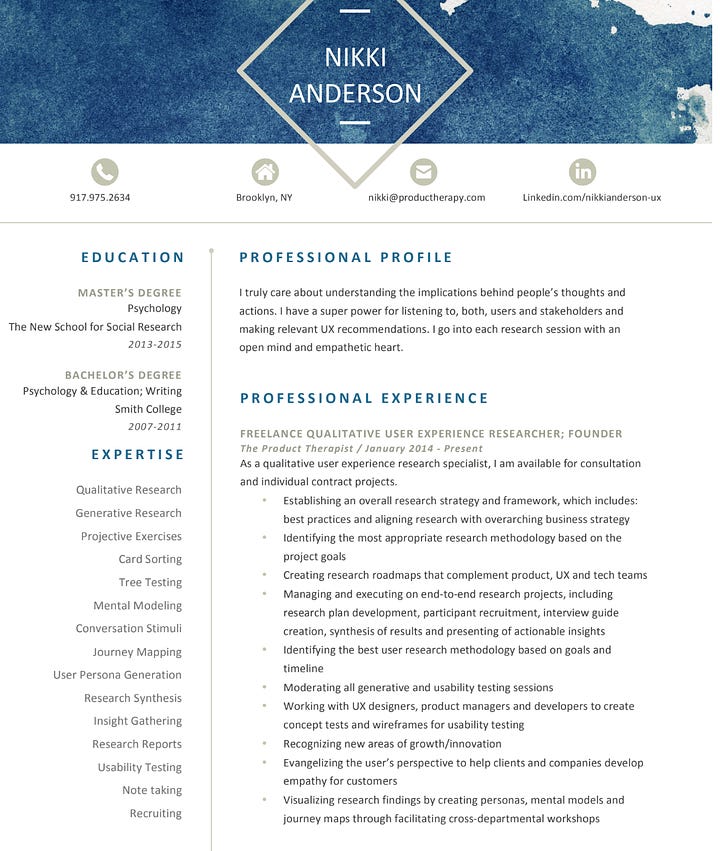
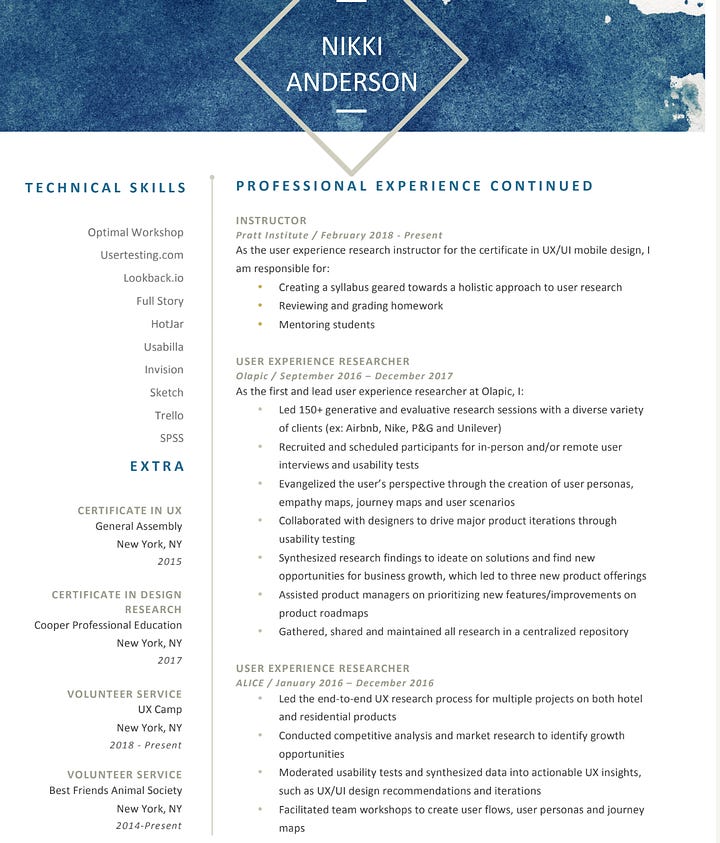
Okay, great, I didn’t go too far off the beaten path again with the format, so at least that’s a plus.
I also cleaned up my bio a bit to be more geared toward the relevant aspect of my work, around listening to both users and stakeholders to make relevant recommendations. However, I didn’t include any sort of impact I had or anything specific to the work I’ve done or specialized in, which is an ideal thing to have in your bio.
One thing I did really poorly in this resume included my freelancing as the first bit of experience I shared, while my full-time work was relegated to the next page. The reason this was a problem was because I wasn’t applying to freelance positions, I was looking for a full-time role. So, when we go back to the 30-second rule of someone scanning my resume and the decision they are trying to make, I am not providing the best information for them.
I also make another mistake of repeating information in two separate bullets 🙄
Additionally, the points under my freelance experience are so incredibly vague and obvious.
“Managing and executing on end-to-end research projects, including research plan development, participant recruitment, interview guide creation, synthesis of results and presenting of actionable insights”
“Evangelizing the user's perspective to help clients and companies develop empathy for customers”
“Visualizing research findings by creating personas, mental models and journey maps through facilitating cross-departmental workshops”
“Establishing an overall research strategy and framework, which includes: best practices and aligning research with overarching business strategy”
Honestly, this was a whole lot of fluff. It sounds like I just copied and pasted this information from a job description (maybe I did). In this, there is absolutely NO personalization in these bullet points, no uniqueness, no impact, no demonstration of skills. Nothing, nada, zilch. These may even be worse than my first resume because at least those didn’t look like I straight-up copied and pasted them.
On the second page, I see TWO NUMBERs 🎉 that I led over 150 research sessions and that my research findings led to three new product offerings! Huzzah. I had it in me somewhere, but just not enough to put it anywhere else. Most of everything else is extremely dry and fluffy. In fact, a lot of it really does look copied and pasted:
Such as “conducted competitive analysis and market research to identify growth
opportunities.” ????? I don’t even know what that means. This was likely me inserting filler words I’d seen elsewhere in the hopes that’s what people were looking for.
I got a little more specific with my skills, adding in actual methods rather than just “research methodologies.” But this resume was not my best.
A note on authenticity and transparency
Before we hop to the next interation and some concrete examples for improving bullet points, I want to quickly note how important authenticity and transparency is.
By including that last bullet point, “conducted competitive analysis and market research to identify growth opportunities,” in my resume, I was actually setting myself up for failure. I didn’t know how to conduct market research to identify growth opportunities. But it sounded good, and I saw it on many other resumes.
I highly recommend only including your experience and what you would feel comfortable doing at a new organization.
I once got called out in an interview when they asked me about a certain technique I had put on my resume, and it was so incredibly embarrassing to try to backtrack from that. I lost their trust and the job opportunity - rightly so.
Iteration four
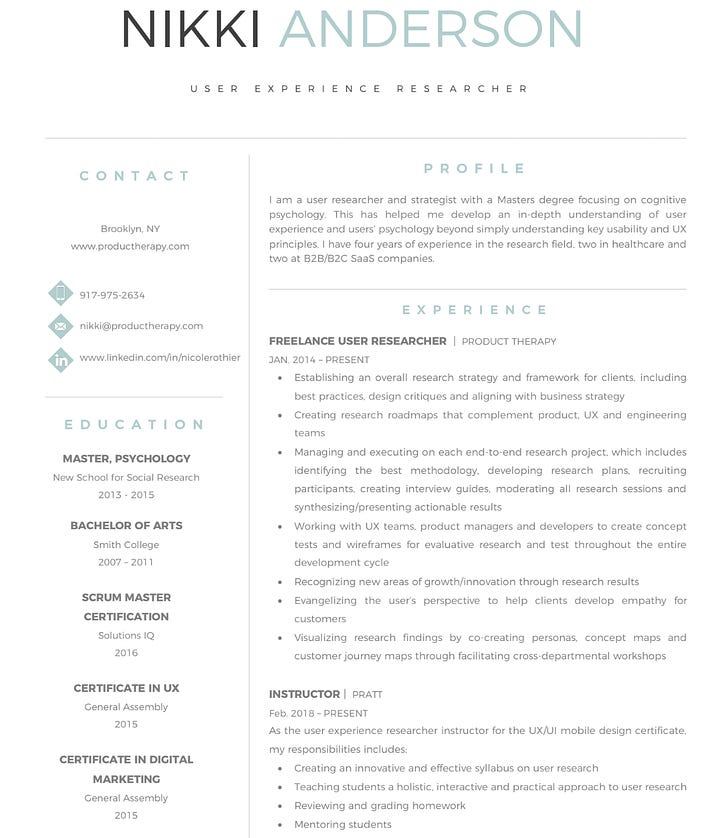
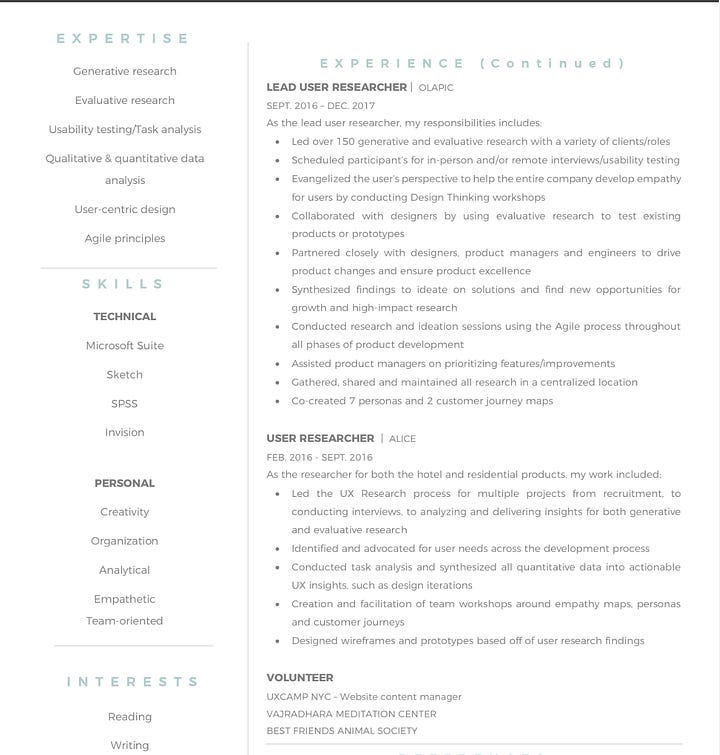
This iteration finally started to get a bit better. Unfortunately, I still kept my freelance work on the first page, AND it was still hugely generic, so no points for that.
However, if you ignore that entire first page (the most important part of a resume, mind you 😂), you will see that I started to improve my quantifying a bit under my Olapic role.
For instance, I included the number of personas and journey maps — BUT, big note, including a number below 10? Write it out (ex: nine). 10 and above, use the numerical. So, this line should read: “co-created seven personas and two customer journey maps.”
I tried to get a bit more specific, but I was still, again, hugely lacking in quantifying, consequence, and specificity.
Let’s fix it
Instead of just telling you all the things I did wrong on my resume, let’s look at six of these less-than-ideal bullet points so that we can improve them together:
Fix one
Bad: Assisted product managers in prioritizing new features/improvements on product roadmaps
Better: Created and leveraged three personas to prioritize the feature roadmap, and empowered product managers and developers to write customer-centric user stories
Why: In the bad version, I just say I assisted prioritization, not how or what that actually means. In this better version, I give a concrete example of the work (the three personas) and the consequence of the work (writing customer-centric user stories)
Fix two
Bad: Collaborated with designers to drive major product iterations through usability testing
Better: Conducted over 75 usability tests, which resulted in actionable insights, increasing customer satisfaction scores (SUS) from 46 (below average) to 71 (above average), and increased overall task completion by 23%
Why: I up-leveled this by giving a concrete example of the work I did through usability testing, gave it a number, and also brought through the concrete impact (with even more numbers). This gets really specific
Fix three
Bad: Evangelized the user's perspective through the creation of user personas, empathy maps, journey maps, and user scenarios
Better: Used our service blueprint to inform sales strategy, and reduce client implementation timeline of our product by 50%, from six months to two to three months
Why: I tried to squeeze everything into the bad version, and with that, I diluted my work. Instead, I focused specifically on how the service blueprint informed sales strategy (showing I can work cross-departmentally) and implementation time. Narrowing the scope of your bullet points is really important.
Fix four
Bad: Created and shared insights in creative ways throughout the product team
Better: Used creative sharing methodologies, such as usability bingo and opening night, which aided in executive buy-in and led to a 20% increase in the annual research budget
Why: Again, I got specific and honed into two sharing methodologies to properly demonstrate my skills and I also follow-up with a super important impact of increasing budget
Fix five
Bad: Educated stakeholders on the value of research and democratized usability testing through training
Better: Developed over 20 user research templates and curriculum to teach 10+ colleagues how to conduct usability sessions, leading to a 30/70 split in evaluative and generative research
Why: By quantifying what democratization meant more clearly (20 templates) and how many people I taught, this statement becomes a lot more valuable. I also end with the impact of enabling more generative research
Fix six
Bad: Built a research framework and practice for end-to-end research projects
Better: Created a user research structure and framework, which placed user research within an agile environment and reduced wasted development time by 45%
Why: Creating a framework is great and something I always see on resumes, but what does that framework enable? Here, I make a quick fix of adding a quantifier and the consequence to help drive that impact.
There are SO many ways to improve each of these bullet points, depending on the experience you have and what you are trying to convey to the hiring manager. Definitely take the time to think about how to add these components to yours (formula below in case you get stuck)!
The current version
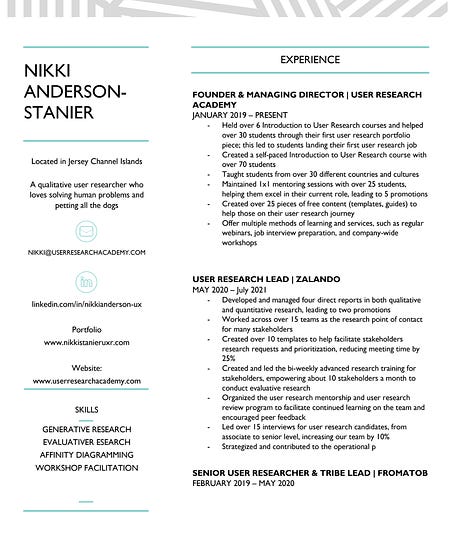
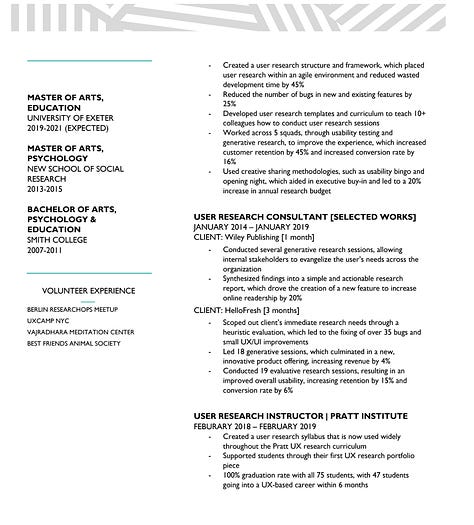
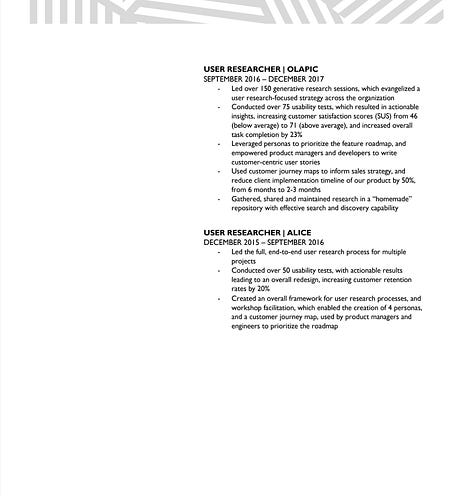
The current version of my resume considers everything I mentioned above about giving hiring managers the necessary information upfront to make the best decisions they can, including concrete examples and impact.
Of course, there are always things to improve, but I am grateful for the lessons I learned through these iterations!
Use these techniques
Did you have a nice laugh looking at my resumes, but now, faced with yours, you just want to shred it into a million digital pieces? No fear. I have some techniques for you to use to make it easier on you!
The job description
The job description should be your best friend! Use the job description to understand the types of skills you should be demonstrating on your resume. I usually have a “standard” resume, and I determined what should go on it by looking at A LOT of job descriptions, finding patterns and trends across them, and synthesizing the most important job responsibilities. I recommend doing the same for the job you are looking for — it definitely helps ensure you have the right information on your resume!
Use my formula + words
To help you out, you can use this formula when transforming your bullet points:
[Power verb] + [what you did] + [quantifier] + [consequence transition] + [consequence/what happened because]
Conducted over 75 usability tests, which resulted in actionable insights, increasing customer satisfaction scores (SUS) from 46 (below average) to 71 (above average), and increased overall task completion by 23%
Word vomit, then perfect
Trying to get the perfect sentence the first time is torture. Don’t do it. I’ve done it 84392547 times enough to tell you it doesn’t work. Instead, word vomit. Put everything you did (sans formula) down into a Word document. I mean all of it.
Then, go through the bullets and see if you can create a formula from them. If you can’t, then move that bullet point down the list. Once you have five to seven formulas for a role, start to rank them in the level of importance. Pick the top three to five for each role that is most relevant to the job you are applying to.
Have a backlog
Ideally, your resume reflects the job you are applying for. These days, there are qualitative, quantitative, and mixed-methods user researchers. There are also UXRs that specialize in start-ups or a particular industry. There are those who rock at processes and frameworks.
What I always recommend doing is having a backlog that has all of your work (you can use your Word vomit doc) so that if a job calls for a different skill set than your “standard” resume, you can just grab it from this list.
For instance, I am more of a qualitative researcher, but I have extensive experience in surveys. If I applied for a job that asked for more quantitative-based skills, I would go to my backlog and pull out more of those bullet points to show relevant experience.
Etsy is great
Not a designer? Hey, same! I hate designing resumes (or anything, really). Literally, my husband makes fun of anything I design. When in doubt, I go to Etsy and check out resume templates! I love supporting a small shop and not having to design anything!
Don’t have experience?
I highly recommend doing some personal projects or volunteering. I talk about this in-depth in this video!
Don’t wait!
Your dream job (or at least a better one than you’re in now) could come along at any point. I’ve been SOL several times when an awesome job came my way because I wasn't ready with my resume. I told myself, “oh, I’ll throw this together in two hours after work.” HA! Nope. My resume (clearly, as you saw) wasn’t at that point, and I let a lot of opportunities slip by because of that.
I recommend updating your resume every one to three months so that it is in the most tip-top shape, just in case!

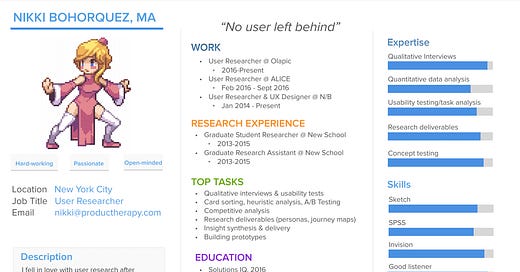



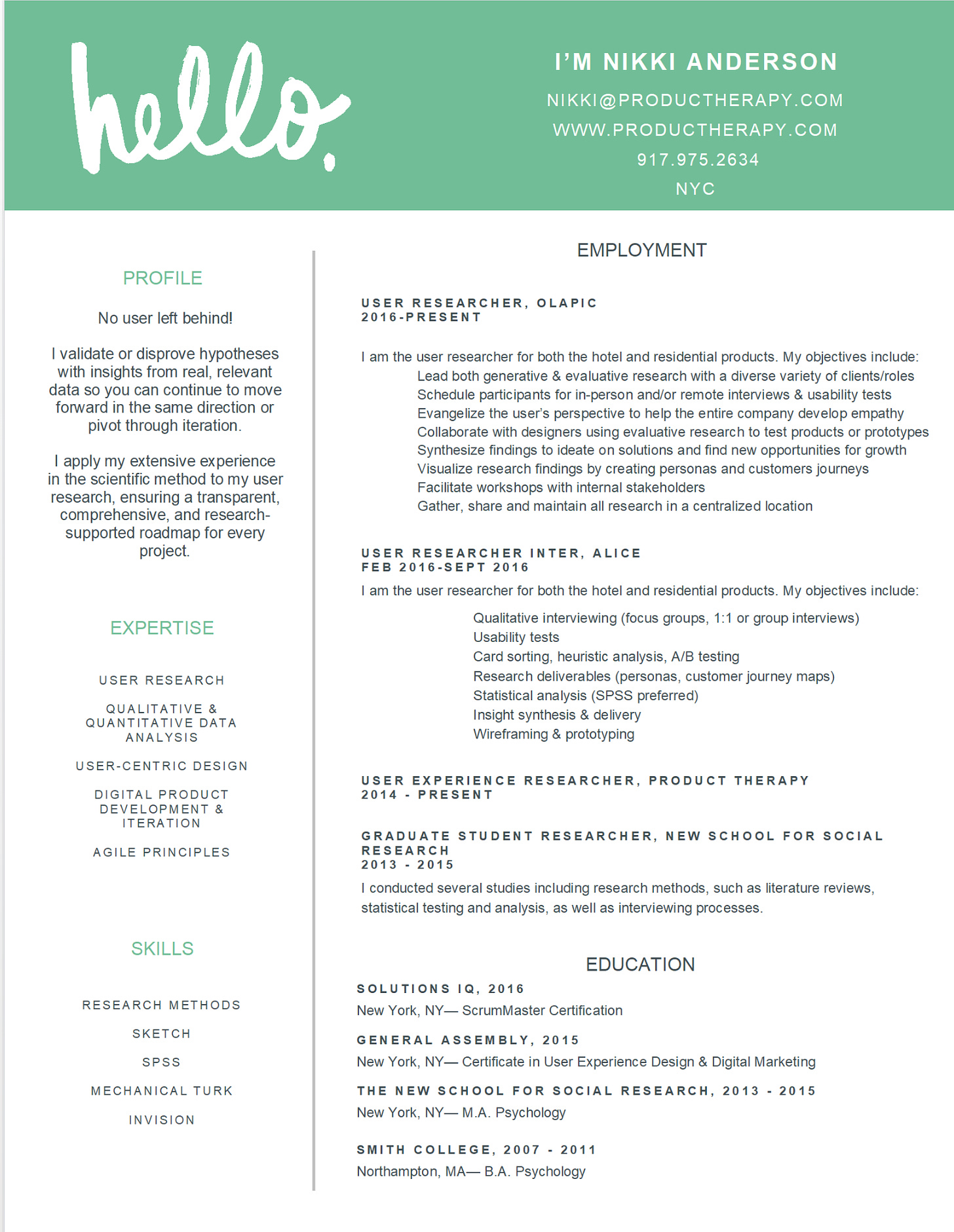
This is hands down the BEST resume guide I've ever seen (and I've seen many!). Thank you Nikki!!!
Excellent article! I'll be sharing it with all of my mentees!